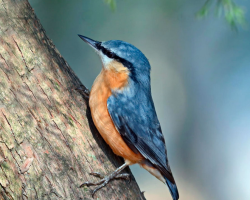The turtle in nature is a representative of the ancient inhabitants of the planet, the uniqueness of the animal lies in the unusual design of the skeleton, in which the bone system is connected to a solid protective shell in the form of a shell. The shell of the turtle protects it from the negative impact of the world and makes it one of the slowest animals on the planet.
Content
- Turtle: description, characteristic
- The benefits of turtles in nature
- The structure of the body of the turtle
- What does the turtle look without the shell look of and what does it look like?
- The shell of the turtles
- Does the turtle have teeth and how much?
- How does the turtle breathe?
- How to determine the floor of the turtle?
- Where do the turtles live in nature?
- What do turtles eat in nature?
- How are the turtles propagated and born?
- How many eggs does a turtle lay?
- Why do sea turtles lay eggs at night?
- How do turtles winter?
- Why do turtles live long?
- Video: the largest turtles in the world
In total, there are more than 200 types of turtles. Most of them have a low weight and reaches several tens of centimeters in length. The weight of large species reaches 700-900 kg, while the main weight is focused on the shell. The smallest variety has a weight of 100-200 g. Turtles can live both in the wild and at home. You can find out a lot of useful things about home turtles here.
Turtle: description, characteristic
- Different species are adapted to their habitat - some prefer water, others live on land. Water reptiles are predators. Their diet includes fish, mollusks, invertebrates. A land turtle in nature is mainly eaten by plant foods.
- Turtles are long -livers. The average life expectancy is 150-200 years. These animals inhabit the planet Earth more 200 million years. In addition to bone shelter from adverse factors, nature endowed turtles with good vision and excellent hearing. When cold weather, the turtles go hibernation.

The benefits of turtles in nature
- Turtle in nature It is a natural link in a chain of power. In ancient times and in modern food industry, meat turtles are used for cooking.
- The turtle shell is used for decorative purposes and in jewelry. Symbolism of turtles is used in mythology, art, in heraldry.
- Turtles are representatives of the ancient variety of animals and record holders of longevity. Unique animals deserve a careful attitude of a person.
The structure of the body of the turtle
- The turtles are very well developed The muscles of the limbs. The mammal overcomes long distances on his paws, moving on himself huge heavy shell.
- The head of the animal has stressed shape for comfortable disguise inside the shell. In most varieties, the eyes are located on the sides of the head and directed to the bottom. The absorption of food occurs using a hard front beak.
- In land turtles The front limbs are adapted for digging the soil, the hind legs allow you to push the heavy shell forward. In freshwater species, dense membranes are formed on the paws, connecting fingers into fins. Moving in water occurs mainly with the front paws, so their size significantly exceeds the rear.
- All types turtles They have a small one the tail of pointed shape. Several exotic species have a conical spike on the tip. The cervical and tail parts of the spine are mobile, the rest of the skeleton is connected to the shell.

What does the turtle look without the shell look of and what does it look like?
- Another one the uniqueness of the turtle in the presence of an internal and external skeleton. The shell of the turtles grows tightly with the ribs and vertebrae, without it the life of the animal is not possible. The presence of a bone structure limits the development of the muscles of the body.
- The thoracic region is built oblong vertebrae turning into the sternum. In the tail of the turtle is 33 vertebraeproviding him with mobility. Bones of the hips Very short and are an integral part of the frame and spine.
- Freshwater turtle in nature is found with a frame made of soft fabrics covered with rough skin. Relatively lightweight contributes to rapid movement and performs protective functions when meeting with danger.

The shell of the turtles
- The main feature in the structure of the turtles is the shell. The abdominal frame has a flat shape. Bone formation, located along the spine, has the shape of a semicircle. The upper and lower part of the shell are interconnected by bone membranes.
- The surface of the shell is covered with horn scales. Its strength can withstand a load exceeding the turtle by 200 times. The scales of the shell and the rough skin of the body are updated during molting.
- The shell is reliable for the animal shelter. At the slightest threat, the mammal easily transforms the soft parts of the body and hides them under the bone box. The cervical muscles allow you to completely pull the head inward, leaving only point holes for breathing outside.
- Any mechanical damage to the shell in the form of scuffs or cracks can provoke fungal disease. Therefore, despite the external invulnerability, the turtles must be treated very carefully.
- Together with protective functions The shell of the turtle helps to maintain heat. Blood vessels pass inside it. Due to the many nerve endings of the turtle, pain and discomfort with mechanical effects on the bone plate can feel.

Does the turtle have teeth and how much?
- There are no teeth at the turtle. Food chewing is carried out using horn plates covering the inside of the mouth and pharynx. The embossed coating easily copes with solid products, grinds plant tubers and stems.
- Abundant salivation It contributes to the formation of food lumps, which for a long time can be in the mouth and in the esophagus. Food promotion is carried out using massive language. The limited functionality of the language does not allow you to stick it out of the mouth.
- In individual types of turtles, the tongue is covered taste receptors. Varieties that do not feel the taste, less too much in food. Digging one meal of the turtle can last about a week. The digestive tract depends on the temperature regime.

How does the turtle breathe?
- The turtle breathes through the nasal passages. The holes of the nose are easy to notice on the front of the head. Separate varieties have a small elongated proboscis.
- At the turtles there is no chest, that's why voluminous lungs Fill the entire upper part of the space under a semicircular shell. The heavier the bone armor, the greater the volume of the lungs. When inhalation in the body of the turtles occurs reducing muscle ligaments and pulmonary muscles.
- The breathing of the turtle is measured. Its frequency depends on the living conditions of the mammal. Freshwater and sea turtles are kept without air for several hours, after which they need to emerge to the surface of the water and get a new portion of oxygen. Land mammals are made around 5 breaths per minute.
- Several varieties of sea turtles use alternative breathing methods - through the surface of the skin or special sinuses in the respiratory system. Features of the structure of the respiratory system of mammals exclude reflex coughing or sneezing. The mucus retention in the respiratory tract often leads to the development of pneumonia.
How to determine the floor of the turtle?
Sexual differences in the turtles can only be seen with a careful examination. The external differences between the male and female sex of mammals include:
- The shape of the shell. In the female, the shell is stretched in an oblong shape, in males the shape is more similar to the flattened oval.
- The shape of the plastron. On the bottom of the shell from the side of the tail in males, a recess is provided, facilitating the propagation process. The females in this section Plastron are flat.
- The length of the tail.The tail of mammals of the female elongated and straight. In males, the tail is longer and massive at the base.
- The location of the cloaca.In females, the anus is at the base of the tail and has a rounded shape. In males of a cloak in the form of an elongated seed, it is placed in the lower third of the tail.
- Nail length.Male representatives on the front paws are much longer than the females. This feature is a convenient tool for mating.

Where do the turtles live in nature?
- Sea varieties of turtles live in the seas and oceans. Heat -loving animals prefer tropical and moderate climate. On cold continents, the animal will not be able to survive, so he chooses territories with warm open flow and coastal waters. For access to air sea turtles Stay closer to the surface of the water and often become a catch for people.
- Ground turtles They prefer territories with an arid climate. Animals inhabit the desert and steppe lands in the south of Europe, in Australia, America, Africa . Several species live in tropical wet forests. In the mountains, you can meet the turtle at a height 1-1.5 km. There is about 60 varieties of land reptiles.
- Freshwater turtles live in Europe and Asia near various freshwater reservoirs. Small rivers, lakes, seasonal reservoirs are preferable. Freshwater turtles in Russia are found in the regions of the North Caucasus.
- Unusual pond slider In nature, it is found in the territories of North and South America. In Italy, they are considered pests of plants. You can find out more about the red -eared turtle here.
- Kaymannaya turtlewho is able to bite a person, is found in the territories of Canada and the USA. A large green turtle lives in the seas of the Pacific and Atlantic Ocean.
What do turtles eat in nature?
- Turtles belong to omnivorous animals. The diet of sea and freshwater turtles consists of fry of fish, crustaceans, mollusks, tadpoles. Large individuals hunt large fish and frogs. Hungry turtle Able to eat a defenseless relative.
- Land turtles eat mainly plant food. Animals eat plant stems, vegetables, fruits, mushrooms. Under favorable conditions, do not mind enjoying small insects and small animals from reservoirs.

- Returned food is easier to chew, so turtles do not refuse to rotten fish and spoiled fruits.
- At home, pets are replaced by familiar food algae, salad leaves, vegetables, aquarium fish and snails.
How are the turtles propagated and born?
- During the propagation period of the behavior of the turtle, it is possible to install its floor. Interested males surround females obsessive attention, repulsing it from the rivals. In the behavior of males, rhythmic swaying their heads and touching the face of the female with front limbs are noted.
- The female behaves more indifferent. To ignore the female, the male individual begins to aggressively bite.
- Depending on the habitat puberty of turtles It occurs at different ages. Freshwater turtles are ready to bear offspring at 6-8 years old, lands lay eggs From 10-15 years.
- Mating can occur both on land and in water. The duration of sexual intercourse is a quarter of an hour. The male individual is pressed against the female due to the concavity of the lower part of the shell. Fixes the position with clinging with tenacious claws or embracing flat fins.

How many eggs does a turtle lay?
- Turtles are located for fertilization only in comfortable conditions - at a favorable ambient temperature and a well -fed stomach. The active period of reproduction falls in the spring.
- To protect their offspring, females lay eggs in a well -known territory. Warm summer sand near water sources is the most comfortable place for future turtles.
- Medication period at the turtle The offspring is 1-3 months. Mammals are able to withdraw up to 200 eggs 3-4 times throughout the year. Only units manage to survive in wildlife conditions. Eggs enjoying the eggs, fish, predatory animals, and even people.

Why do sea turtles lay eggs at night?
- To lay eggs, sea turtle You need to get out on land. You can see how the turtle lays eggs in nature only at night. In order to avoid a large accumulation of people, females give preference to dark time of day. Ground turtles Not tied to night time.
- For neat distribution of masonry tortoise eggs He pulls out a deep hole with its hind legs. The eggs are deposited by order. For the convenience of the turtle It is immersed in the hind legs into the recess and evenly places the future offspring.
- Ready masonry mammal It buries with sand, evens out the surface with the lower part of the shell and moistens with its own discharge. The participation of the Turtle’s mother ends on this. The fate of future offspring is completely dependent on environmental conditions.
How do turtles winter?
- With the onset of cold weather turtles They fall into winter hibernation. The animal dugs the earthen den and falls asleep in it until the climate change. The hibernation period lasts from the beginning of winter to warm spring.
- For hibernation, the right thing is important the temperature regime and state of health of the animal. Adverse factors can lead to turtle disease during sleep.
- Thanks to healthy winter hibernation, the life expectancy of the animal increases, hormonal processes are regulated, excess fat deposits are processed.

Why do turtles live long?
- How many turtles live In nature, it directly depends on environmental conditions. The main secret of longevity of turtles is that they are cold -blooded animals.
- They do not have to spend energy on heating of your own body, and, therefore, the metabolism occurs at a very measured pace. It is scientifically proven that quick metabolism reduces life expectancy.
Turtles eat quite a little, a long period without food does not affect the functioning of the body. Not a frequent process of digestion of low -calorie foods reduces the metabolic load on the body, such conditions are favorable for long life of turtles.
- At home, the life expectancy of turtles is reduced.
- With proper care, the pet can live for about 50 years.







